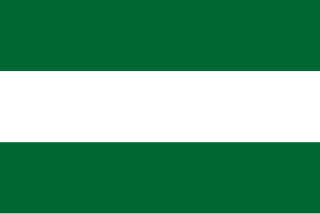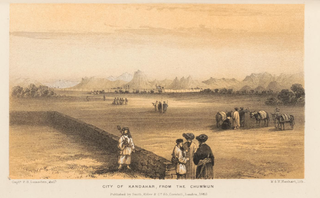
Abdur Rahman Khan also known by his epithets, The Iron Amir, or The Dracula Amir, was Amir of Afghanistan from 1880 to his death in 1901. He is known for uniting the country after years of internal fighting and negotiation of the Durand Line Agreement with British India.

European influence in Afghanistan has been present in the country since the Victorian era, when the competing imperial powers of Britain and Russia contested for control over Afghanistan as part of the Great Game.

Emir Dost Mohammad Khan Barakzai, nicknamed the Amir-i Kabir, was the founder of the Barakzai dynasty and one of the prominent rulers of Afghanistan during the First Anglo-Afghan War. With the decline of the Durrani dynasty, he became the Emir of Afghanistan in 1826. He was the 11th son of Payendah Khan, chief of the Barakzai Pashtuns, who was killed in 1799 by King Zaman Shah Durrani.

The First Anglo-Afghan War was fought between the British Empire and the Emirate of Kabul from 1838 to 1842. The British initially successfully invaded the country taking sides in a succession dispute between emir Dost Mohammad Khan (Barakzai) and former King Shah Shujah (Durrani), whom they reinstalled upon occupying Kabul in August 1839. The main British Indian force occupied Kabul and endured harsh winters. The force and its camp followers were almost completely massacred during the 1842 retreat from Kabul.

The Second Anglo-Afghan War was a military conflict fought between the British Raj and the Emirate of Afghanistan from 1878 to 1880, when the latter was ruled by Sher Ali Khan of the Barakzai dynasty, the son of former Emir Dost Mohammad Khan. The war was part of the Great Game between the British and Russian empires.
Sultan Ahmad Khan b. Sardar 'Azim Mohammadzai, also known as Sultan Jan was the ruler of the Principality of Herat from September 1857 to April 1863. He was a nephew of Dost Mohammad Khan. In 1855-56, Sultan Ahmad Khan sent a petition to the Shahanshah. If they would support Sultan Ahmad Khan with an army he would overthrow the Amir-i Kabir and annex Afghanistan into the Guarded Domains. He was intercepted by Dost Mohammad Khan though and exiled Sultan Ahmad Khan to Iran. When the Anglo-Persian War ended he was installed as ruler of Herat by the Iranians. On May 24, 1857, he arrived in Herat. The Iranians evacuated Herat in September 1857 in accordance with the Treaty of Paris. During his reign, he was completely dependent on Iran and not only minted coins in the Shahanshah's name, but also repeatedly given support upon request against the Mohammadzais. Naser al-Din Shah bestowed the title of Sirkar on Sultan Ahmad Khan and bestowed the title of Amir Panji on Sultan Ahmad Khan's son, Shah Nawaz Khan.

Nasrullah Khan, or Amir Muhammad Nasrullah Bahadur Khan, was the Emir of Bukhara from 24 April 1827 to 20 October 1860. His father was Emir Haydar bin Shahmurad (1800–1826).

Kamran Shah Durrani was born in the Sadozai dynasty. He was the son of Mahmud Shah Durrani, grandson of Timur Shah Durrani and the great grandson of Ahmad Shah Durrani, the founder of the Durrani Empire. He was deposed and killed in early 1842, by his vizier Yar Mohammad Khan Alakozai.

Bilateral relations between Afghanistan and the United Kingdom of Great Britain and Northern Ireland span a long and eventful history, dating back to the United Kingdom's Company rule in India, the British-Russian rivalry in Central Asia, and the border between modern Afghanistan and British India. There has been an Afghan embassy in London since 1922 though there was no accredited Afghan ambassador from 1981 to 2001.

The Herat campaign of 1862–1863 was a conflict between the Principality of Herat and the Emirate of Afghanistan, from March 1862, when Sultan Jan captured Farah from the Muhammadzai Emirs and continued through the 10-month long siege of Herat, ending on May 27, 1863, when the city fell to the Amir-i Kabir, thus completing the unification of Afghanistan.

The Principality of Herat, the Emirate of Herat, the Herat Khanate or simply Herat was a state in Afghanistan from 1793 to 1863, and one of the 3 main khanates in 19th century Afghanistan.
The Afghan Civil War was fought from 9 June 1863 to January 1869. It began as a result of Dost Mohammad Khan's death on 9 June 1863 and the subsequent power struggles among his sons. Dost Mohammad consolidated his power in the second half of his reign within his inner family. His sons were appointed governors of provinces and effectively acted autonomous from the central government. This would inevitably lead to his sons fighting for control after his death.
The Maimana Khanate was an Uzbek Khanate in Northern Afghanistan centered around the town of Maimana. It was founded in 1747 with the death of Nader Shah. The Mings had been the governors of Maimana since 1621. Hajji Bi Ming was the first independent ruler of the khanate. After the death of Ahmad Khan in 1814, Sar-i Pul seceded from the khanate. In the 1830s Sar-i Pul took the district of Gurziwan from Maimana. The Aimaq tribes of the Murghab broke away from Maimana by 1845. In 1847 and 1850 it resisted attempts by the Emirate of Herat to annex it. In 1875 the khanate rebelled against Afghanistan but it was crushed and the city sacked. In 1892 the khanate was annexed by Afghanistan.
The Expedition of Shuja ul-Mulk began in January 1833, whilst the siege of Kandahar began on 10 May 1834, and ended on 1 July 1834. The expedition was led by Shah Shuja Durrani, the deposed Afghan Emperor who wished to re-claim his throne. Shah Shuja rallied forces while in exile in the Sikh Empire and marched through Sindh to Kandahar, besieging it. Shah Shuja would be defeated by the Barakzai rulers of Kandahar and Kabul.
The Hazarajat Campaign of 1843 began as a result of the post First Anglo-Afghan War situation in Afghanistan. Behsud and Bamiyan had broken away from Afghan rule as a result of the war, and Dost Mohammad sought to reconquer it following his resumption of power in Kabul.

The Conquest of Kandahar took place on 14 November 1855, and its consolidation lasted as long as September 1856. Following the death of Kohandil Khan, the ruler of Kandahar under the Dil brothers, the region had fallen into a succession crisis between Rahmdil Khan, the brother of Kohandil, and Kohandil's sons, who wished to gain power for themselves. Dost Mohammad Khan, the ruler of the Emirate of Afghanistan, sought to take advantage of the anarchy and chaos, and conquer Kandahar for himself.
The Afghan Turkestan Campaign of 1838-39 began in the winter of 1838 and ended in March 1839. The campaign was sent as a result of the tyranny of the Kunduz Khanate's ruler, Murad Beg. It was also launched for reasons such as additional revenue gain and tribute from many of the Uzbek states present in the region, including an attempt at subjugating the prominent states of Khulm and Qataghan. Dost Mohammad also feared the rise of Murad beg and that the Kunduz Khanate was slowly enroaching on Bamiyan.
Dost Mohammad's Campaign to Jalalabad (1834) took place in Early 1834, prior to the summer invasion of Shah Shuja Durrani in Kandahar. Dost Mohammad Khan wished to raise troops and subjugate the regions around Jalalabad, which was ruled by many different polities, one of the most significant being Mohammad Zaman Khan, who was centred in Jalalabad. This invasion from Dost Mohammad would be opposed by the rulers of Kunar, and the Mohmand tribe.
The Afghan Conquest of Balkh took place from the spring of 1849, to January 1850. Dost Mohammad Khan returned to the throne following the First Anglo-Afghan War, and continued pursuing his ambitions for the complete reunification of Afghanistan following its collapse from the civil war among Timur Shah's sons. Dost Mohammad began had entered the region once again in 1843 after being restored to the throne in the Hazarajat Campaign of 1843, extending his influence to Bamyan and many other regions. Dost Mohammad continued his ambitions into the region especially due to external threats such as Bukhara and the Emirate of Herat.
Fateh Khan Barakzai or Wazir Fateh Khan or simply, Fateh Khan, was Wazir of the Durrani Empire during the reign of Mahmud Shah Durrani until his torture and execution at the hands of Kamran Shah Durrani, the son of the ruler of the Durrani Empire, and Mahmud Shah Durrani, and other prominent conspirators such as Ata Mohammad Khan. Fateh Khan was of the Barakzai tribe, and his death caused the enmity of his tribe, leading to his tribe revolting and the eventual deposition of Mahmud Shah Durrani.












